The snake plant (Dracaena trifasciata) is growing to be such a popular houseplant thanks to its unique appearance and hardiness.
In fact, they’re so tough that you could place one in a completely dark room for months, and not only would it survive… it would even grow!
I know, it sounds incredible, but we’ve seen it. They won’t look all that happy, but they can really survive in the toughest conditions, making them great for anyone new to indoor plant care.
In this article, we’ll take a closer look at what makes the snake plant so special, including its physical characteristics, fascinating history, and air-purifying abilities.
Plus, we’ll provide you with all the information you need to care for your snake plants and help them thrive.
Table of Contents
Snake Plant Care Guide
History, Habitat, and Characteristics
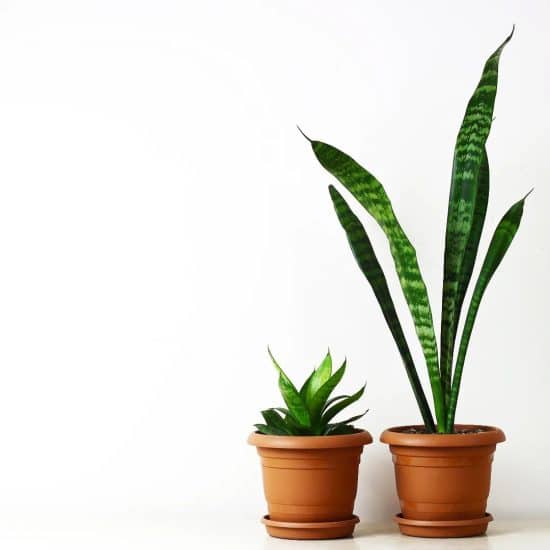
If you’re in search of a hardy and distinct indoor plant, look no further than the snake plant (Dracaena trifasciata). Native to tropical West Africa, this houseplant has been cultivated for centuries due to its unique appearance and resilience.
You’ll first notice that the snake plant has no visible stems; only long leaves that grow vertically up from the soil. You’ll often see green leaves streaked with pale, silver greys. Some variegated snake plants come with golden or cream-colored edges to the leaves.
The plant’s size can range from tiny tabletop varieties to some that’ll grow as tall as your ceiling and windows let them.
Fun fact: Until 2017, the snake plant was known as Sansevieria trifasciata. However, due to its similarities to Dracaena, it was reclassified as Dracaena trifasciata. Its botanical name comes from the Greek words “drakaina,” meaning female dragon, and “trifasciata,” meaning three-banded, describing its three vertical lines of leaf markings.
(Some even call them mother-in-law’s tongue, but we’ll be avoiding that to keep the mother-in-laws happy… is “viper’s bowstring hemp” any kinder?)
In Nigeria, snake plants are believed to keep negative energies away and protect homes from evil spirits. They’re usually placed outside homes for protection.
Well, those beliefs have been borne out, because snake plants are some of the best air-filtering plants you can find. this plant is active at night, so consider placing one in a bedroom to filter your air while you snooze.
Varieties

There are over 50 different varieties of snake plants, but we’ll go over those we see most commonly. These are the easiest to get ahold of, so you probably should be able to find these locally.
(Care will be generally the same for any of these Dracaena trifasciata varieties.)
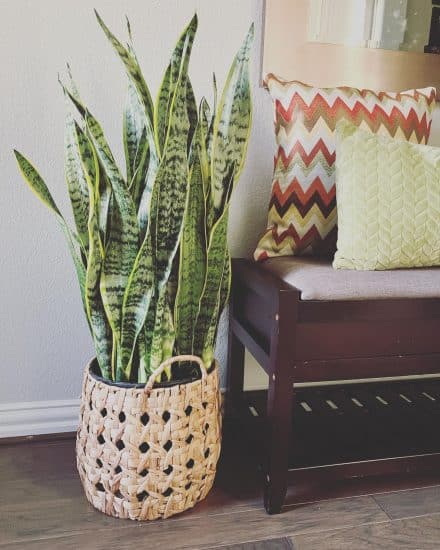
Laurentii: A distinctive, tall variegated succulent Dracaena that loves light. Sword-like leaves that shoot straight up with brilliant yellow edges.

Zeylanica: Completely green, a variegated form without the yellow of the Laurentii, but very nice dark and light green camouflage that runs into silvery greys.
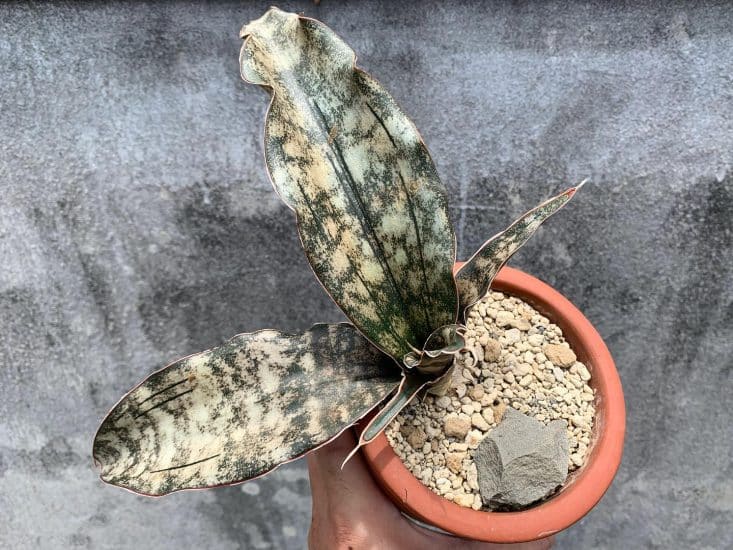
Kirkii: This snake plant should look quite different, looking at home in a dusty desert scene. A smaller, bushy look ranging from sandy browns through mottled coppers. Grows in a rosette pattern and loves bright light. You’ll also notice really firm and stiff leaves.
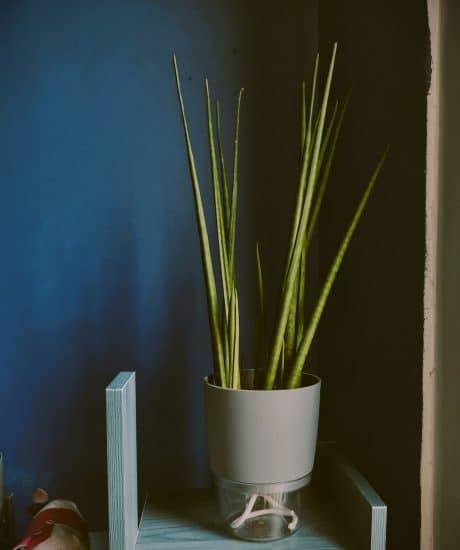
Bacularis: Taking its name from the Latin for rod (Baculum), these almost cylindrical leaves that poke right up, very popular as part of a minimalist Scandi look. Straight, clean, geometrical form. You can either stand these straight up or splay them out, as the rhizomes give you a lot of control.

Cylindrical snake plant: Also known as Dracaena angolensis, this plant features little round spears that shoot right out of their soil in a beautiful arrangement of greens. Very succulent-like. Many people will braid the leaves. While this discourages growth, it does seem to produce a greater amount of pups, so something to consider if you’re thinking about propagation!
(Keep in mind that a variegated snake plant will require a bit more light than plants with greener leaves.)
Picking Out Your First Snake Plant

When picking out your snake plant, you can first evaluate the varieties above and decide which really appeals to you. Then when you find yourself at the shop . . . what do you actually do?
You’ll start by looking at the plant’s leaves. Try to pick one out that doesn’t have burnt edges or black spots (fungus, bacteria, or root issues).
Next, you’ll want to feel the leaves. They’re covered with a very thick cuticle that protects the surface. They should feel waxy and even. If they don’t, move on to the next plant.
Now look at the root ball and base of the soil for new shoots, little baby plants coming out. We often recommend that you remove a pot to inspect the roots, but you might want to hold off on this approach with Dracaena trifasciata.
This can be a slow growing plant, at least its root system. Younger plants with immature roots could have been recently repotted at the grower, and if they were . . . you’ll be in for a surprise when you take that pot off and soil spills all over the place.
Better to try this technique outside.
Generally, with a snake plant, if the plant itself looks fine, the roots should be fine too, so you can let them stay in their pots.
You’ll want a lot of individual shoots. Your Dracaena trifasciata could be three or more plants that are all sharing the same pot. If you see lots of new shoots and starters coming out of the soil, this is a great sign for the health of your plant, and you’ll have a fuller look in the future.
Dracaena trifasciata can look faded in color if they’re exposed to too much light in the greenhouses where they are grown. This breaks down the cuticles and makes them look more opaque and faded. If you have the choice, pick the plant with the brightest, clearest colors available, with thick, healthy cuticles.
Transportation is pretty easy as long as things aren’t below freezing. If they are, ask to have your plant wrapped up first before bringing it home so it doesn’t get shocked.
If the only Dracaena trifasciata leaves you see look a bit sad, that’s okay too, because they’re pretty hardy plants!
Light
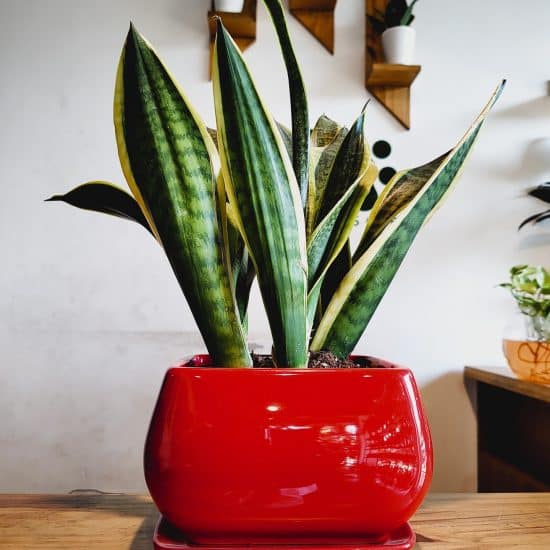
Snake plants can be placed anywhere in your home. Really!
Now, I wouldn’t recommend placing your plant in direct sunlight all day, so do avoid a south-facing window. Your plant will survive ,but this will destroy its cuticles (weakening the plant), and the entire plant will look pretty pale and sad.
If you must use a window like this, add a sheer curtain or move your plant slightly out of the direct sun.
This plant loves light. So any other location with lots of bright, indirect light is going to be great.
Too little light: You’ll notice a very slow-growing Dracaena trifasciata, with almost no variegation. When variegated plants don’t get enough light, they over-produce chlorophyll to extract all of the energy they can from the light they do get. The side effect of this is, as you might guess, that chlorophyll colors the entire leaf green, making it lose its style and detail.
Lighting tips:
- You can detect low light conditions by seeing if your plant’s leaves are bending toward the source of light instead of standing straight up.
- If your snake plant’s leaves are turning yellow, brown, and crispy at the edges, this is likely due to too much direct sunlight.
- Provide bright, indirect light: Place your plant where it can get bright but indirect light, especially a variegated snake plant.
Water
When you hear that the Dracaena snake plant is a semi-succulent plant, that should be an immediate signal to you that it won’t really want a lot of water, because it has evolved to store it in its leaves.
While Dracaena trifasciata are resilient, water is the one place they can suffer.
We often hear that you should water a plant just when the soil dries out. If you read through a lot of care guides you’ll see it mentioned time and time again. This is one of the plants where that is absolutely essential.
It should not just be dry, but completely dry. Other plants, you might water weekly. This plant is a lot happier being watered close to monthly. Really!
Signs of too much water: you’ll likely start seeing black spotting on its leaves, which could be from fungus or bacteria. These spots can appear anywhere on the leaves, often throughout the middle. Really let your plant dry out, even if the leaves start to wilt.
Root rot is another issue from overwatering, often from standing water and not having drainage holes, or using really moist soil. Its leaves will physically feel soft, wet, mushy, and you’ll see/smell them rotting.
We’ll cover how to deal with this in our last section.
Temperature and Humidity
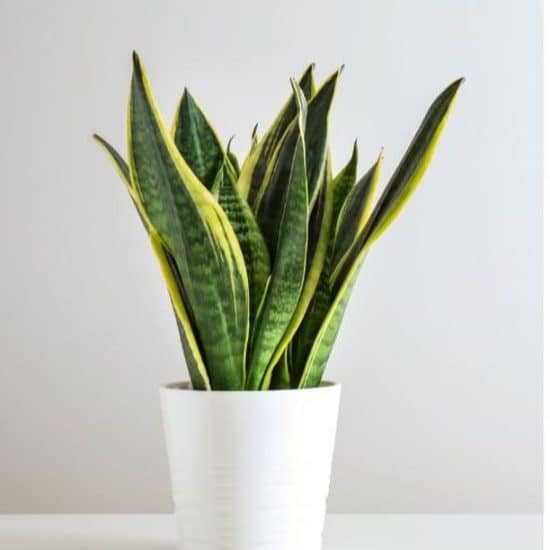
Snake plants are pretty forgiving with both temperature and humidity. Getting these right will result in a faster-growing snake plant that looks more vibrant and healthy.
Getting them wrong? You might not notice too much, honestly!
Temperature: Really watch out for cold drafts. This is the largest concern, in the winter especially. Move your plant away from any windows that you’ll be opening in the winter if it’s 50°F or cooler. Similarly, keep an eye on any ACs in the summer. Radiators aren’t that much of an issue – this really is a tough plant that can thrive in a variety of environments.
Humidity: Dracaena trifasciata doesn’t actually care about humidity. If you want to be picky and really get things right, you will see faster growth with a humidity around 50% or higher.
Many recommend misting a Dracaena trifasciata to increase the local humidity. Sad to say, this doesn’t work unless you want to stand there all day like a giant humidifier. Instead, you can wipe down the leaves of your snake plant with a moist cloth.
Wiping down the leaves has a few benefits: it helps unclog the stomata, which are like the lungs of your plant, letting them freely exchange air. It also cleans off any potential pests, and gives you a monthly opportunity to inspect your plant and make sure it’s happy.
Just a little,”Hey, snake plant, how are you doing?”
Soil and planting

A good potting mix for Dracaena trifasciata should be well-draining, with a 70-30 ratio of standard potting soil and perlite.
Perlite really helps aerate the soil, making sure it won’t stay wet for too long. Snake plants really prefer to dry out between watering.
Signs of a poor soil mix often include yellowing bottom leaves, curled edges, and soft, mushy leaves. If your soil remains waterlogged, you’ll likely get root rot and other bacterial/fungal issues.
When you plant a snake plant in soil that absorbs a lot of water, like normal potting soil, it has access to water all the time, remains moist, and is generally terrible for the plant. You want soil with good drainage so that excess water can leave, giving the roots some room to breathe.
Fertilizing
Dracaena trifasciata doesn’t want fertilizer more than twice a year. I’d aim for once in the spring growing season and again in the mid-summer. A complete, balanced liquid fertilizer works great, and dilute it plenty, because less is definitely more.
Too much fertilizer shocks the roots, and you’ll see burn marks across the leaf on any part of it, especially the tips, as the plant tries to push these overkill nutrients out.
Repotting
When you get your snake plant home from the store, don’t repot it immediately. Their root systems grow very slowly, and if you keep repotting snake plants, they may fall apart. From personal experience, if your leaves are all pointed straight up, just let them be, or you could be in for hours of minor adjustments.
(Ever adjust a picture frame? Imagine a pot full of them. I’m not cut out for that.)
If you see roots coming out the pot’s outer edges, or it’s bulging with roots, just go with one a little bit bigger—one size up is fine.
Now, Dracaena trifasciata do grow faster in larger containers, but the larger the container, the longer the soil takes to dry out, which this plant doesn’t like. So help those roots stay dry and keep the pots on the smaller side.
Larger containers also have more room for the rhizomes/root stems that these plants send out. From those stems, new baby plants will shoot up, so larger containers do have more room for these lil plants to grow.
For material, terracotta is fantastic, since it helps the soil evaporate moisture. But a glazed or nursery pot is just fine as well.
You’ll want to make sure your pot has plenty of drainage holes, and you can place it in an outer decorative pot if you like.
Just don’t let standing water accumulate in the bottom of that outer pot, or you’ll have a very irritated snake plant. Hsssss.
Propagation guide
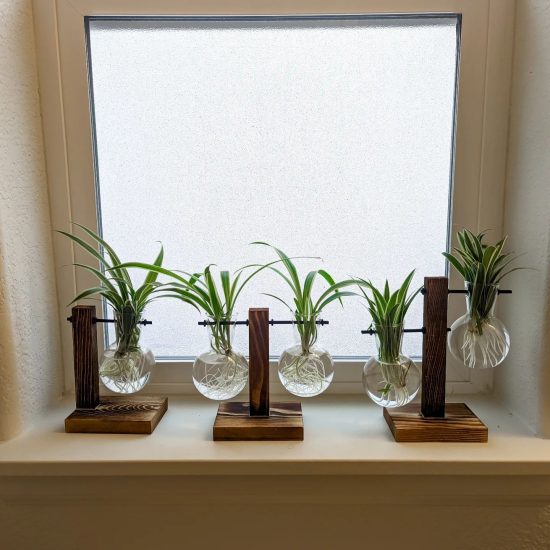
There are so many ways to propagate snake plants. Normally we’d stick to just one, but let’s actually cover all of them, because this is one of our favorite indoor plants.
First, propagating in water and soil both works, but it’s so much easier to propagate snake plants in water.
In soil, you have to get the soil mix just right: not too wet, but moist; good drainage . . . but not too quick draining; high humidity, watering constantly. It can be tough.
In water? Easy, just change it up every few days.
First, we’re going to cover division.
Propagating Snake Plants by Division

Division is great when you have a plant growing out of its pot and you actually do need to take a few of them out. This makes space for roots and new pups, and maybe you have a leaf growing at an angle, so let’s replant it!
- Take the plant entirely out of its pot. A light thwap on the bottom usually does it! If you have a nice root system, you’ll see the soil sticks together. If the roots look small and the soil is not sticking together, you’ll want to wait before dividing.
- Brush away the soil and find the root stem of a plant, then pull away until you uncover it.
- Once you find the root stem, wiggle it out and detach it from the soil, not harming the roots. If it breaks off, that’s totally fine. You want to cut so that you have at least 2-3 inches of root stem.
- Fine roots should also be coming out of that stem. Re-pot the old plant, dump the extra soil back in, and your original plant can go back to its normal care
- With your new propagation, you’ll want to plant it in the soil down to where the green of the leaf starts. The rest should be beneath the soil.
No special care is really required after this because it’s a mature, healthy plant from the start. Just water normally and place it in the same conditions as the mother plant.
Propagating Snake Plants by Leaf Cutting

First, this method does take time – 2 to 4 months, to be specific. It’s fine to start this any time of the year, but spring and summer are a little more successful because it’s just sunnier and usually a bit more humid inside.
- Cut off a section of the plant with clean shears. We don’t want to impart any bacteria or fungus. You can boil your shears in water or wipe them down with alcohol.
- Cut off the bottom of the leaf, and now you have a cutting ready to put in any jar or vase. Tap water or filtered water works fine.
- Place the leaves in the water. Unlike other plants, you don’t need to let the wounds callus or heal.
- Swap the water every few days, weekly, as often as you can remember.
- Keep the cuttings in a bright spot, and in a month or two you’ll see small roots.
- Once roots grow to be 1-2 inches, in a month or two, then you can re-pot into the soil mixture described in our section above.
- When transplanting, put a few inches into the soil so that the leaf doesn’t tip over. You can really place as deep as you want, but 2-3 inches minimum.
If you wait too long to replant these, roots can become water roots and it will be more difficult to transplant into soil.
Also, sometimes if you cut the bottom of your leaf flat, it can sit right at the bottom of your jar, making it hard to form roots. Instead, you can cut at an angle or even cut a notch into the bottom of the leaf to ensure that water can flow up into the leaf.
(This also increases the surface area of the potential rooting space, giving it more space to suck up the water.)
Multiple Leaf Cuttings
When you take a cutting, you can cut each leaf into sections 3 inches long. Keep track of which side of the leaf was originally pointing up so that the bottom of your leaf remains in that orientation.
To propagate, we’re going to follow the same method as for a single cutting. Grab a jar and place your stack of cuttings in around an inch of water.
Once roots start to form, you can divide these leaves into multiple glasses, though you’ll have to change the water a bit more often. 2-3 months later, you can transplant them into soil.
Bonus: Planting your stem root. If you’re left with a stem root from cutting off the leaf, you can replant this or let it remain in the soil, and it too will propagate in a few months with new growth.
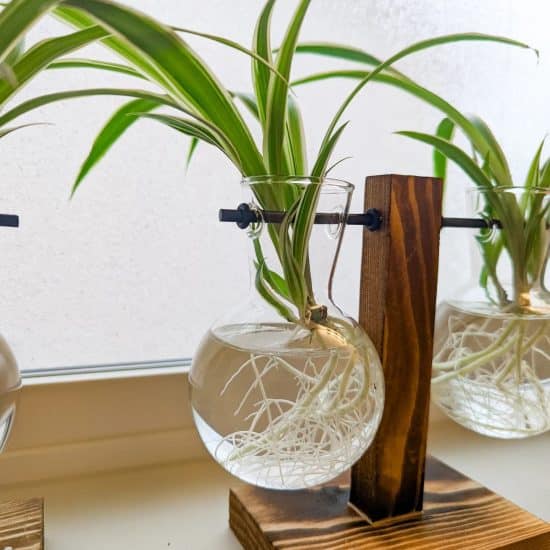
Common Issues

Snake plants are hardy indoor plants, but issues can and do occur. Don’t worry, we’ll guide you through the most common issues that snake plants face, and how to identify and solve them.
Yellowing Leaves
Yellow leaves are most often caused by overwatering. As hardy as your snake plant is, watering is really its Achilles heel, as they are prone to issues like root rot. They need their soil to dry completely before watering.
Make sure your plant is in a well-draining soil mix, and don’t let water sit in a saucer under the pot.
Yellowing leaves can also be caused by sudden exposure to cold temperatures. Dracaena trifasciata is pretty tolerant of temperature fluctuations, but will show signs of stress if temperatures dip below 60 degrees Fahrenheit for too long.
If you notice yellowing leaves and suspect that temperature is the issue, it’s time to find a warmer location in your home.
Wilting Leaves
If your snake plant’s leaves are starting to show signs of wilting, it’s often a water issue.
Check to see how moist the soil is. If the soil feels dry, water your plant.
If watering isn’t the issue, pay attention to your snake plant’s location. Too much light can cause the leaves to wilt. Try moving your plant to a shadier spot away from direct sunlight or south-facing windows.
Brown Tips
Are you noticing brown tips? The likely culprit is a build-up of excess fertilizer in the soil or minerals in your tap water. To solve this, rinse the soil thoroughly while your plant in the sink or bathtub and let the water run through it for a few minutes. You may want to switch to filtered or rainwater as well.
Diseases and Pests

Pests
Pests are always a potential threat, but less so with snake plants because of their waxy surface and semi-succulent leaves. Pests have trouble getting through, so if your plant is healthy, you may never have an issue with them.
If pests do appear, it’s often mealy bugs, because they’re pretty big and can bite pretty hard. This usually happens to an unhealthy plant with a weakened cuticle.
How to get rid of snake plant pests:
- Isolate your plant away from the rest while you treat it – you don’t want the issue spreading.
- Remove any mealy bugs or spider mites with a blast of water or manually with an alcohol-covered cotton ball. Then apply neem oil to all sides of the leaves, reapplying in two weeks.
Spider mites are really hard to see, and you’ll often notice their webs first. Like your snake plant, mites really dislike water, so you can gently wipe down your leaves with a damp cloth once a month to discourage them, or keep your plant in higher humidity.
Now it’s time to restore your snake plant to proper health. What happened in the first place? Usually, it’s because… can you guess? Too much water!
Root Rot
One of the main causes of root rot in snake plants is overwatering. If you notice that the leaves are turning yellow or soft to the touch, these are signs that the roots may be rotting.
Keep in mind that mature roots on a snake plant often do look dark brown or yellowish, so you’ll want to really investigate to make sure they’re slimy/mushy too. Gross, sorry!
Once you’ve confirmed you do have an issue:
- Take your snake plant out of its pot and cut off any that are soft and mushy or discolored. Use sterilized shears or a clean knife.
- Any discolored, damaged leaves should be pulled out entirely. These can’t really be propagated, so just toss ’em.
- Re-pot in a well-draining potting mix, add perlite or pumice to keep the soil light, and make sure the pot has at least several drainage holes so that your roots don’t sit in standing water or waterlogged soil.
Conclusion

That’s it for our snake plant care guide! You should have a pretty good grasp on a few methods of propagation, how to deal with whatever comes up (mostly likely watering issues), and up at the top, we have a pretty good overview of what buying your first Sansevieria should be like.
So whether you call it Sansevieria trifasciata (very old school of you), Dracaena trifasciata, or just plain ol’ mother-in-law’s tongue (risky), this is a plant that will treat you well.
Plant care summary:
- Dracaena trifasciata can be propagated by both leaf cutting and root division. Make sure to pick a healthy leaf without any obvious damage.
- These plants grow well in conditions ranging from partial shade all the way through direct sunlight.
- You’ll want to use a well-draining potting soil made up of regular potting soil and perlite, or potting soil and a succulent mix.
- Soggy soil leads to root rot, while loose soil leads to a happy plant.
We hope this guide was helpful for you! Send us pictures of your plants as they grow up, and get in touch if you have any questions about this or any other houseplant.
Take care, and happy growing!
FAQ
Are snake plants safe to have around pets?
Snake plants are considered toxic by the ASPCA, and it’s recommended you keep pets (cats and dogs) and small children away from these plants to be safe.
Can you plant snake plants in a self-watering container?
You can absolutely use a self-watering container, even with plants that like to dry out a bit. Once a month or so, you can let the water run all the way out so that the soil has a chance to dry. Once you notice dry soil, it’s time to refill your container and let it be.
Is pruning snake plants easy?
This plant loves to grow, so it’s likely you’ll want to prune it at some point, especially if it starts to lose that straight, geometric look. You’ll want to remove the whole leaf, right at the soil level, but you can also trim the leaves directly.
Just keep in mind that trimming does scar over and will look like a damaged end, so we really recommend just taking out the entire leaf.
Do snake plants flower?
They do, and like with other Dracaena plants, you’ll want to keep them from flowering if possible. They aren’t especially beautiful flowers, so just cut them away at first sight, as they sap nutrients from the plant and secrete a sticky substance that’s sappy and unpleasant. Plus, many Dracaena species will die right after flowering, leaving a few pups behind.


